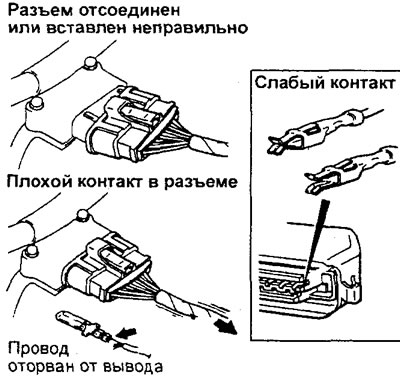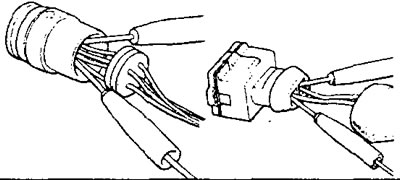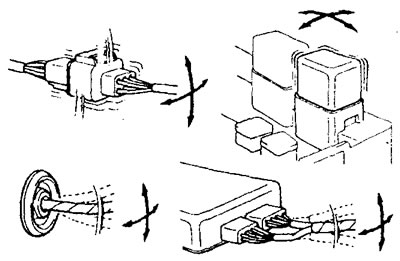Attention: see the section "Safety measures during work" chapters "Maintenance and general inspection and adjustment procedures".
Precautionary measures
1. Before troubleshooting the fuel injection system, check that the engine settings are correct (see chapter "Maintenance and general inspection and adjustment procedures").
2. Before disconnecting the connectors of the electronic control unit, it is necessary to turn off the electrical power by either the ignition key or by removing the terminals from the battery.
Attention: be sure to read the diagnostic codes before disconnecting the wires from the battery terminals.
3. When installing the battery, do not reverse the polarity of the wires connected to its terminals.
4. Do not hit the elements of the fuel injection system and especially the electronic control unit.
5. Be careful when troubleshooting, with a large number of transistor circuits, even light careless touching of the terminals can cause serious damage.
6. Do not open the housing cover of the electronic control unit.
7. When operating in rainy weather, keep the electronic controls away from water. The same should be done when washing the engine.
8. Be careful when disconnecting and connecting electrical wiring connectors.
9. To avoid misfiring after repairs, take the following precautions.
A) Check up reliability of connection of wires with plugs of the storage battery.
b) Handle high voltage wires with care.
V) At the end of the repair work, make sure that all wires of the ignition system are correctly and securely connected.

Checking connectors
1. Connecting and disconnecting connectors.
A) When disconnecting, loosen the lock by pushing the spring and pull out the connector by holding it by the housing.
b) When connecting, fully insert the connector and make sure it is locked.

2. Checking the quality of the connection in the connector.
Attention: malfunctions in the electronic control system can be caused by incorrect connection of the electrical wiring connectors. However, when checking the system, the symptom may disappear if the connectors are repeatedly disconnected and connected. Possible causes of such malfunctions are:
- - The connector is disconnected or the connector is connected incorrectly.
- - Loss of connector pins.
- - Poor contact in the connector due to excessive tension on the wiring in the connector.
- - Weak contact due to corrosion of the connector pins, ingress of foreign particles.

A) If the pin stopper in the connector is damaged, the pins may fall out from the back of the connector even when the connector is connected. Therefore, it is necessary to carefully pull each wire on the back of the connector and make sure that there are no pins falling out.
b) To check the reliability of contact between the terminals, use a special tool. The withdrawal force must be at least 1 N.
3. Check on connector pins.
Attention:
- Never use force when connecting the probe, as this may damage the lead or cause poor contact in the connector. If you cannot insert the probe into a socket that is too small (electronic control unit, etc.), it is necessary to use an extra fine stylus.
- Be very careful when checking to avoid short-circuiting the leads. A short circuit of the terminals can damage the circuits inside the electronic control unit.
4. Peculiarities of checking for the output of hermetic connectors.
Attention: when testing circuits with sealed (waterproof) connectors, it is recommended to use the test lead harness.
A) If the test lead harness is missing, carefully remove the protective cover.

b) When testing resistance, current, or voltage, always insert the tester probe from the wire side.
Attention: never insert the probe directly into the connector from the wire side through the protective cover, as this will lead to a violation of the tightness of the connector and the appearance of corrosion of the contacts.

V) After checking, firmly install the protective cover on the connector.
Wiring check
1. When checking the wiring harness for an open, when the ends of the wire being tested are far apart, use a wire with a connector "crocodile" to connect one end of the wire to "weight", and then check for a closed circuit between the second end» wires and "weight". If the circuit is open, repair the wiring.
Note: however, when checking the power line wire for an open circuit, check for a closed circuit directly between both ends of the wire, without using a connector "crocodile" to connect one end of the wire to "weight".
2. When checking the circuit for a short circuit (on "mass") disconnect one end of the wire and check for an open circuit between "weight" and the other end of the wire. If the target is closed (short circuit), then repair the electrical wiring.
Note: As a general rule, use an analog ohmmeter or multimeter when checking circuit condition.
If the wiring is OK, but the voltage (nutrition), supplied to the sensor is different from normal, substitute a known-good engine control module and recheck.
Caution: As a general rule, use a digital voltmeter when checking voltage (or multimeter), however, when checking the voltage in the power transistor circuit, you should change the analog voltmeter.
Connector designations
Connector pin numbering on the device side (for intermediate connector, connector side "dad") indicated when looking at the connector from the pinout (from the connecting side of the connector).


General scheme of the fuel injection system (MPI, 4G93 engine).1 - oxygen sensor, 2 - mass air flow sensor, 3 - absolute sensor (barometric) pressure sensor, 4 - intake air temperature sensor, 5 - throttle position sensor, 6 - camshaft position sensor, 7 - crankshaft position sensor, 8 - engine coolant temperature sensor, 9 - knock sensor, 10 - fuel injector, 11 - EGR valve servomotor, 12 - adsorber purge solenoid valve, 13 - idle speed control servomotor, a - to the fuel tank, b - fuel pressure regulator, c - from the fuel pump, d - forced crankcase ventilation valve, e - catalytic converter, f. adsorber, g - air filter, h - air.
Note: signals marked "☆ " components used by the electronic control unit (signals from the ignition switch are also used (conclusion "ST" And "IG"), power lines, vehicle speed sensor, air conditioner switch, start inhibit switch, power steering hydraulic fluid pressure switch, air conditioner load signal, output "FR" generator); noted "☆ " components are executive devices (together with the fuel pump relay, the main injection system relay, the relay for the magnetic clutch of the air conditioning compressor, the indicator "CHECK ENGINE", ignition coil, electric fan controller, self-diagnostic circuit, terminal "G" alternator, oxygen sensor heating element, tachometer).
Checking the circuit with a blown fuse
1. Remove the fuse and measure the resistance between "weight" and load contact of the fuse.
A) Set the switches of all circuits related to this fuse to the closed position.
b) If at the same time the resistance is almost zero, then a short circuit occurs in the circuit between the switches and the load.
V) If the resistance is greater than zero, then there is currently no short circuit. However, the momentary short circuit caused the fuse to blow.

2. The main causes of short circuit are:
- A) Pinching the wire with a body part.
- b) Insulation damage due to wear or overheating.
- V) Water ingress into a connector or circuit,
- G) human error (erroneous shorting of the circuit, etc.).
Search for intermittent malfunctions
1. Intermittent faults (when the symptom may not reappear) often occur under certain conditions and if these conditions can be established, then it is easy to determine the cause of the malfunction. To determine the conditions under which a malfunction occurs, first of all, information is needed about the driving conditions of the car, weather conditions, frequency of repetitions and symptoms of malfunction.
2. Perform a simulation test to reproduce the conditions for the failure to occur.
A) When the main cause of the malfunction is probably vibration then:
- - Gently shake the connector up and down, right and left.
- - Gently shake the wire up, down, right and left.
- - Gently shake each sensor, relay, etc. by hand.
- - Gently shake the wire harnesses on the suspension and other moving parts.
Note: if any wire shows signs of mechanical damage (strong bend, break, insulation cut, etc.), then a new wire must be connected instead.

b) When the root cause of the problem is probably overheating, use a hair dryer to heat up the component that is suspected to be causing the problem.
Caution: Do not heat system components above 80°C.
V) When the main cause of the malfunction is likely to be increased resistance in electrical circuits, then install all electrical appliance switches (including headlight switches and rear window defroster switch) into position "ON" (ON).
G) If the symptom does not reappear even after performing the above checks, then the troubleshooting should be temporarily stopped.
